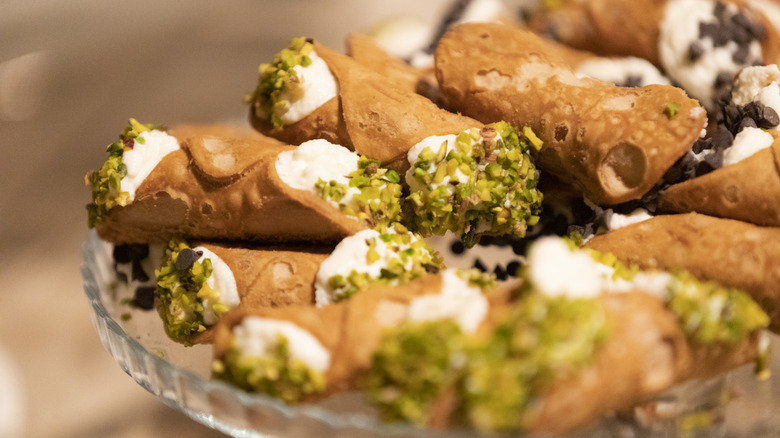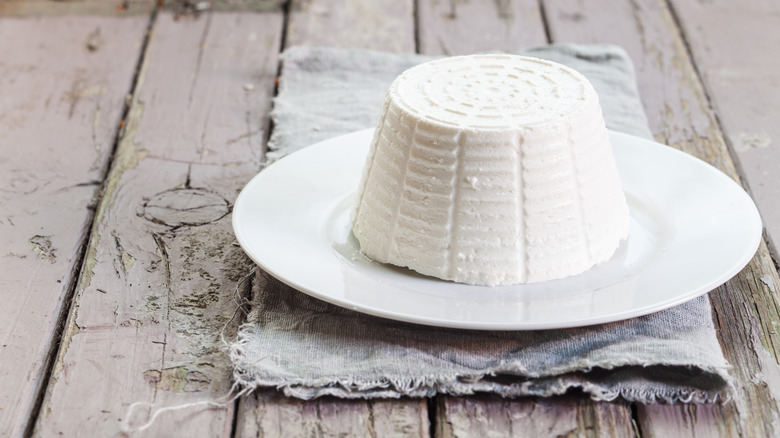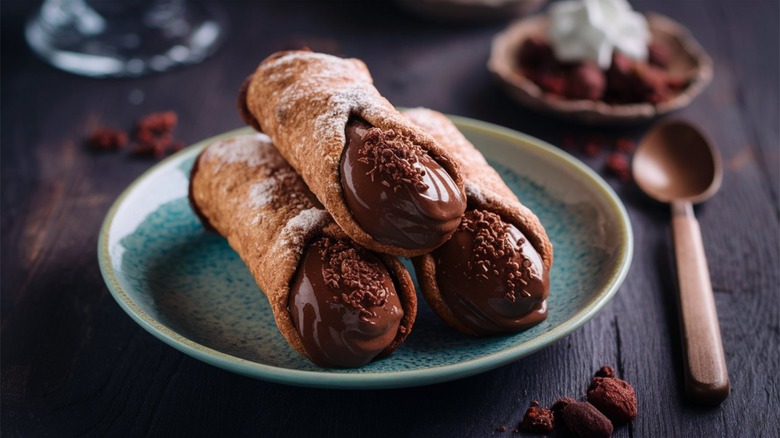What Is Cannoli Filling Actually?
The Italians have blessed us with their fair share of culinary delights — pizza, pasta, and tiramisu (not to be confused with opera cake) are just some of the many dishes that come to mind. But perhaps their most delicious creation to date is cannoli — the crisp, tube-shaped pastries pumped full of a sweet, cream-like filling. Dine at any Italian restaurant, and you'll probably find a version of this treat (the name for which literally means "little tubes" in Sicilian) on the menu; your local Italian bakery or pastry shop is sure to have its own mouthwatering selection to choose from.
While you can be certain that the exterior of these finger-like sweets is pastry – made from a mixture of things like flour, butter, eggs, and sugar, shaped into hollow logs before being deep-fried until golden and crisp — you may be wondering what exactly the deliciously creamy stuff at its center is. What may seem like a nondescript sweet white cream is actually a mixture of ricotta (or sometimes mascarpone) cheese, blended with powdered sugar and vanilla extract to create a taste sensation that will have you hooked from the very first bite.
Not all cannoli are created equal
Interestingly, the filling for American cannoli is actually different from the kind used in Italy. Italians traditionally make theirs with sheep's milk ricotta, rather than the cow's milk variety favored by Americans. Sheep's milk is known for having a stronger, tangier profile, and it gives the cheese a more robust texture — both factors that make for quite a different cannoli-eating experience.
Americans use cow's milk ricotta in their cannoli because it is more readily available, and, likely, because of its subtler flavor. However, this cheese has a considerably looser consistency than the sheep's milk variety, which is where the icing sugar, mentioned earlier, comes in. This — or sometimes another form of starch — is added to the ricotta as a thickening agent and, as such, gives American cannoli a sweeter flavor than its Italian counterpart.
As an aside, Italians prefer their cannoli fillings to be simple, without the use of too many garnishes. The Italian version also typically comes in two sizes — a small 3.5 inch variety called cannolicchio, and a traditional version that's much larger. Cannoli are also piped to order rather than pre-filled, to retain the integrity of the pastry.
How to customize your cannoli filling
Aside from recreating the traditional Italian filling by using ricotta made with sheep's milk should you be fortunate enough to find it, there are plenty of ways to customize the flavor of your cannoli filling when making this treat at home. Due to its creamy and relatively subtle flavor, ricotta cheese is generally pretty forgiving when it comes to adding other ingredients.
If you're a fan of chocolate, consider mixing through a hazelnut spread like Nutella (another mouthwatering offering from the Italians), some melted chocolate, or even a little sifted cocoa powder if you're in a pinch. To really bring things together, top the cannoli with finely chopped roasted hazelnuts and a whole Ferrero Rocher chocolate (again, Italian), secured with melted chocolate.
Another option is to infuse the filling with lemon — some finely grated lemon zest and a squeeze of lemon juice, or a dollop of lemon curd swirled through the filling will give it a delicious, citrusy hit that's distinctly Mediterranean. Using limes or oranges will have a similar effect, and all of these options can be accentuated by using some of the same candied fruit as a garnish. Speaking of fruit, jam, berry coulis, or freeze-dried fruit powder also work, both in the filling and as a topping. Rest assured that whatever route you go, your cannoli — specifically, its filling — is guaranteed to be 'bellissimo.'


